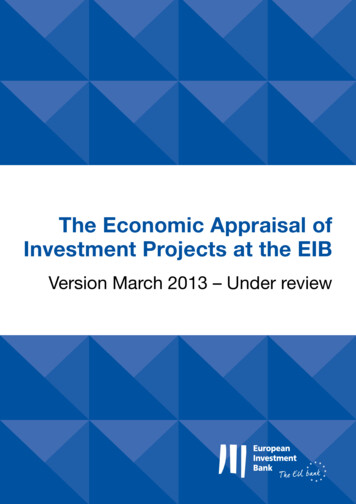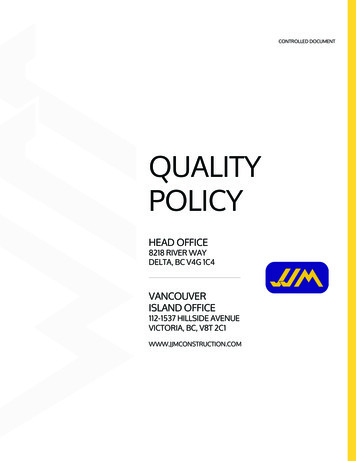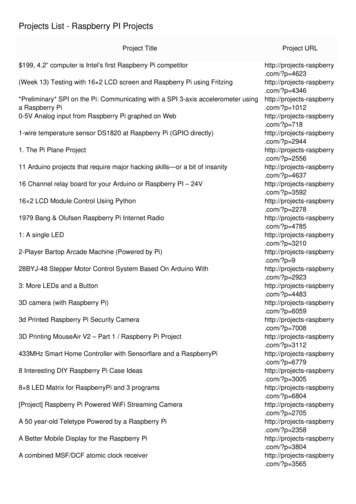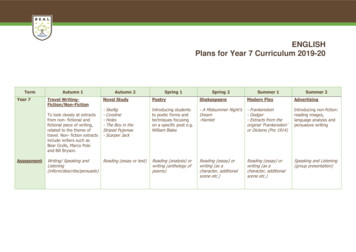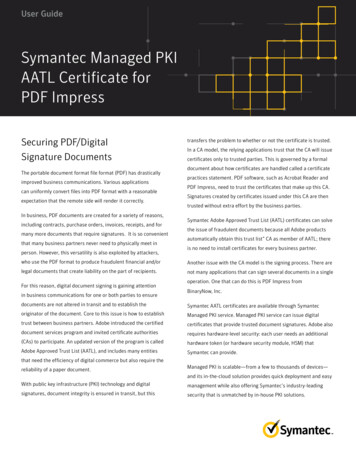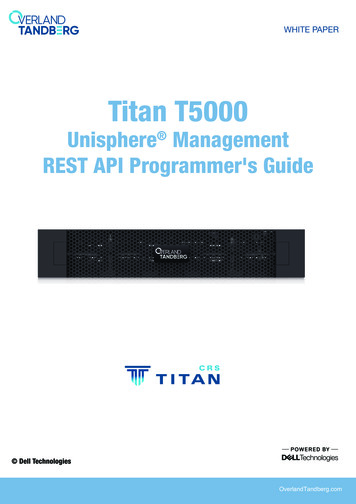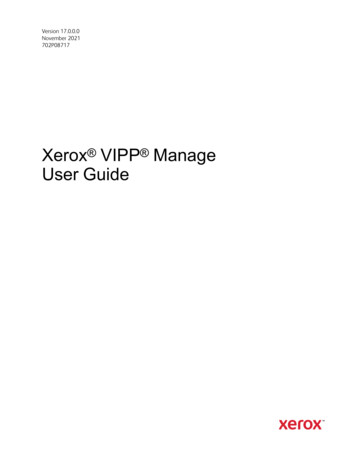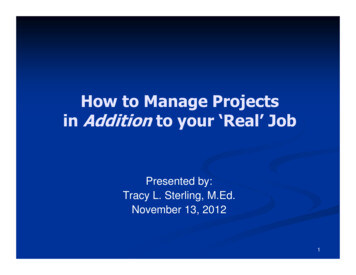
Transcription
How to Manage Projectsin Addition to your ‘Real’ JobPresented by:Tracy L. Sterling, M.Ed.November 13, 20121
Pop QuizWhich of these are projects?A. A company rolling out a new training programB. A homeowner remodeling a kitchenC. A individual or business buying a new vehicleD. A parent running a school or church fundraiserE. A couple planning a family vacationF. A business installing a new computer systemG. A bride-to-be planning a weddingH. A department writing a policy and procedure manual All of the above2
Born to be a Project Manager Some people eat, breathe and sleep projectmanagementSome have a degree or certification in projectmanagementSome have the title of project manager and thatis their primary function within theirorganizations3
So What About the Rest of Us? Most people do project management in additionto their ‘real’ jobs and without any formal trainingMost people invent their own techniques or‘wing it’Most projects are late and over-budgetHelp!4
Session Objectives To learn some helpful basics: How to set ‘scope boundaries’How to effectively manage change and prevent‘scope creep’How to organize a project and assign accountabilityfor the workHow to be more proactive, rather than reactiveHow to manage ‘contingency time’ to avoid misseddeadlines5
There Is A Process InitiatingPlanningExecutingMonitoring and ControllingClosing6
Project Plan What might be included? Scope PlanQuality PlanWork BreakdownRisk PlanSchedule Human Resource PlanCommunication PlanCost EstimateProcurement PlanChange Control7
Project ScopeThe work that must be performed to deliver a product,service or result with the specified features and functions;what needs to be accomplishedScope BoundariesDefinition of what is inside and what is outside theresponsibility of the project.8
Scope CreepAdding features and functionality (project scope) withoutaddressing the effects on time, costs and resources, orwithout customer approval What can scope creep do to a project? Over-budget spendingMissed deadlinesQuality issues – reworkCommunication issuesCustomer/Stakeholder dissatisfactionTeam member frustration9
Change Control How do we control ‘the scope creep’? Know the justification of a changeAssess the impacts of the change Scope Risk Schedule Staffing CostSeek appropriate approvals10
Change Request Form – Sample11
Work Breakdown Structure (WBS) Why create a breakdown of the project? To divide up the workTo assign accountabilityTo determine what the final deliverable(s) for eachsubproject will beTo begin the process of coordinating the efforts of thepeople doing the workTo empower team members to take care of their‘piece’ of the project workTo create a graphic representation of the projectstructure12
Work Breakdown Structure – SampleSUBPROJECTSSoftwareDevelopmentINTERIM DELIVERABLESPrototypeFunctionalSpecUser cept.SignoffUserAccept.TestTest ctNameDesignDocBeta TestSiteDocumentation& TonyClose OutReport13
Proactive vs. Reactive Managing expectations: Is the scope realistic?Is the deadline realistic?Is the budget sufficient?Are the risks manageable?Are the desired outcomes achievable?Find out BEFORE you start the project!14
The Deadline What can cause you to miss a deadline? Not having enough people to do the workDelays in deliveries of materialsRework due to poor workmanshipPeople being out sickToo many changes or additions to the project scopeWaiting for a key person to make a decisionConflicting prioritiesNatural disasters or other crises 15
Scheduling – SampleDel #JorgePMDel #DeliverableNameDeliverableNamePerson AccountablePerson AccountableDel #DeliverableNamePerson AccountableStaff Effort EstimateDuration EstimateStaff Effort EstimateDuration EstimateStaff Effort EstimateDuration EstimateDel #RaoulDDel #Del on AccountablePerson AccountablePerson AccountableStaff Effort EstimateDuration EstimateStaff Effort EstimateDuration EstimateStaff Effort EstimateDuration EstimateDel #DwightMDel #Del on AccountablePerson AccountablePerson AccountableStaff Effort EstimateDuration EstimateStaff Effort EstimateDuration EstimateStaff Effort EstimateDuration EstimateStaff Effort EstimateDuration EstimateStaff Effort EstimateDuration EstimateDel #Del #DeliverableNameDeliverableNamePerson AccountablePerson AccountableStaff Effort EstimateDuration EstimateStaff Effort EstimateDuration EstimateDel #Del #Del on AccountablePerson AccountablePerson AccountableStaff Effort EstimateDuration EstimateStaff Effort EstimateDuration EstimateStaff Effort EstimateDuration eadline1Del #DeliverableNamePerson AccountableBonnieALucindaIDel #DeliverableNamePerson AccountableMileBMileCSponsorDeadline2Mile DMileEMileFMileGDel #Del #DeliverableNameDeliverableNamePerson AccountablePerson AccountableStaff Effort EstimateDuration EstimateStaff Effort EstimateDuration EstimateDeadlineClose OutReport16
The Deadline Tips to avoid a missed deadline? Confirm that the deadline is realistic, given thescope and available resourcesMitigate any risks that could cause delaysEffectively control changeBuild in a ‘pool of contingency’ at the end of theschedule17
ContingencyThe amount of time (or funds) needed above the estimatefor ‘slippage’, to reduce the risk of overrunsAlso referred to as: ReserveBufferSlackFloatDURATIONCYCLE TIMEContingencyCYCLE TIMEContingencyCYCLE ADD ATEND OFSCHEDULEIdleTime18
Summary Basic Concepts and Tools: Scope BoundariesChange ControlWork Breakdown Structure (WBS)Scheduling – to validate the deadlineContingency Management19
Resources Books Getting Started in Project Management by Paula Martin & KarenTate. John Wiley & SonsA Guide to the Project Management Body of Knowledge(PMBOK Guide), Fourth Edition. Project Management InstituteProject Management Memory Jogger by Paula Martin & KarenTate. Goal/QPCWeb Sites www.pmi.org – Project Management Institutewww.swo-pmi.org – Southwest Ohio Chapter of PMI20
Questions?21
Claiming PDUs1.2.Project Management Institute: www.pmi.orgComplete the Reporting Form using the following information: Category: B Program title or description: Practical Project Management: How toManage Projects in Addition to Your Real Job Start date: Nov. 13, 2012 Completion date: Nov. 13, 2012 Hours Completed: 1 Provider Name: Sterling Performance Solutions, LLC Provider Address: 7 S. Kline Ave; Amelia, OH 45102 USA Provider Phone: 513-752-5077 Provider URL: www.sterlingsolutions.us22
Claiming PHR, SPHR and GPHR Credits1.2.HR Certification Institute: www.hrci.orgComplete the Reporting Form using the following information: Program title or description: Practical Project Management: How toManage Projects in Addition to Your Real Job Program ID: (Please contact GCASTD.) Start date: Nov. 13, 2012 End date: Nov. 13, 2012 Credit Hours Awarded: 1 Specified Credit Hours: General23
Thank YouFeel Free to Contact Me Tracy Sterling, M.Ed.Sterling Performance Solutions, LLCPhone: (513) 751-5077Email: tsterling@sterlingsolutions.usWeb site: www.sterlingsolutions.usLinkedIn24
2012, Sterling Performance Solutions, LLCAll Rights Reserved.Version 1.0, 10/2012Some of the material contained in this course is the copyright of Martin TrainingAssociates, LLC.Project Management Memory Jogger (PMMJ) is a trademark of Goal/QPC.PMBOK Guide is a trademark of Project Management Institute.Microsoft Project is a trademark of Microsoft Corporation, Inc.25
Project Management Memory Jogger by Paula Martin & Karen Tate. Goal/QPC Web Sites www.pmi.org - Project Management Institute www.swo-pmi.org - Southwest Ohio Chapter of PMI. 21 Questions? 22 Claiming PDUs 1. Project Management Institute: www.pmi.org 2. Complete the Reporting Form using the following information:


